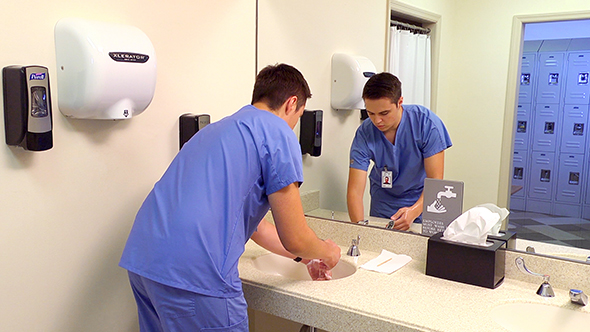Infection Control and Safety Measures
Select a Skill:
- » Performing Hand Hygiene
- » Using Personal Protective Equipment
- » Using Restraint Alternatives
- » Applying Restraints Safely
Take the Review Test:

Purpose

Hand hygiene is the easiest and most important way to prevent the spread of infection. The hands can pick up microbes from a person, place, or thing and transfer them to other people, places, and things. That is why hand hygiene is so very important.
The nursing assistant can perform hand hygiene by:
- Washing with soap and water.
- Using an alcohol-based hand rub.
Equipment
Roll cursor over items to see labels. For the purposes of clearly depicting the equipment, a barrier is not shown in this photo. When providing care, a barrier should always be placed on the surface before placing the equipment.

Water
Soap
Orangewood stick or nail file
Paper towels
Wastebasket
Alcohol-based hand rub
Delegation
This skill does not include delegation content.
Preparation
Plan to wash your hands with soap and water:
- When they are visibly dirty or soiled with blood, body fluids, secretions, or excretions.
- Before eating.
- After using the restroom.
- If exposure to anthrax spore is suspected or proven.
- If an alcohol-based hand rub is not available.
Use an antiseptic hand rub if your hands are not visibly soiled:
- Before direct contact with a person.
- After contact with the person’s intact skin.
- After contact with body fluids or excretions, mucous membranes, non-intact skin, and wound dressings, if hands are not visibly soiled.
- When moving from a contaminated body site to a clean body site during care.
- After contact with objects in the care setting.
- After removing gloves.
Safety

Always practice hand hygiene before and after giving care or handling dirty equipment. This is the best way to prevent the spread of infection.
Comfort
If your hands are chapped or dry, apply hand lotion or cream as often as needed. Use an agency-approved lotion or cream.
Procedure Video
Audio Description: OFFFollow-up Care
This skill does not include follow-up care content.
Reporting/Recording
This skill does not include reporting and recording content.
Review Questions
Select the best answer.
1. What is the purpose of performing hand hygiene?
 To prevent the spread of infection
To prevent the spread of infection To prevent staff contact with infections
To prevent staff contact with infections To keep patients from exposure to bacteria or viruses
To keep patients from exposure to bacteria or viruses To eliminate the need to wear gloves when providing care
To eliminate the need to wear gloves when providing care
Select the best answer.
2. When is it appropriate to use an alcohol-based hand rub to perform hand hygiene?
 If exposure to anthrax spores is suspected
If exposure to anthrax spores is suspected If gloves were worn during patient contact
If gloves were worn during patient contact If the hands are not visibly soiled
If the hands are not visibly soiled If the hands are dry or chapped
If the hands are dry or chapped
Select the best answer.
3. When washing the hands with soap and water, which procedure should the nurse follow?
 Turn on and adjust the water until it feels cool.
Turn on and adjust the water until it feels cool. Keep your hands above your elbows while washing.
Keep your hands above your elbows while washing. Turn off the faucet with your clean dry hand.
Turn off the faucet with your clean dry hand. Use plenty of lather and friction and wash for at least 15 to 20 seconds.
Use plenty of lather and friction and wash for at least 15 to 20 seconds.
Select the best answer.
4. When using soap and water to perform hand hygiene, how much soap should the nursing assistant use?
Select the best answer.
5. As part of performing hand hygiene, how should the nursing assistant dry the hands?
 Let the hands air dry.
Let the hands air dry. Use clean, dry paper towels.
Use clean, dry paper towels. Use a clean, dry cloth.
Use a clean, dry cloth. Place the hands under a hot-air hand dryer.
Place the hands under a hot-air hand dryer.
You have completed the Review Questions for this skill. To take the Review again select the Start Over button. To proceed to another skill select from the dropdown menu. Select the Home or Back button to proceed to the next section.

